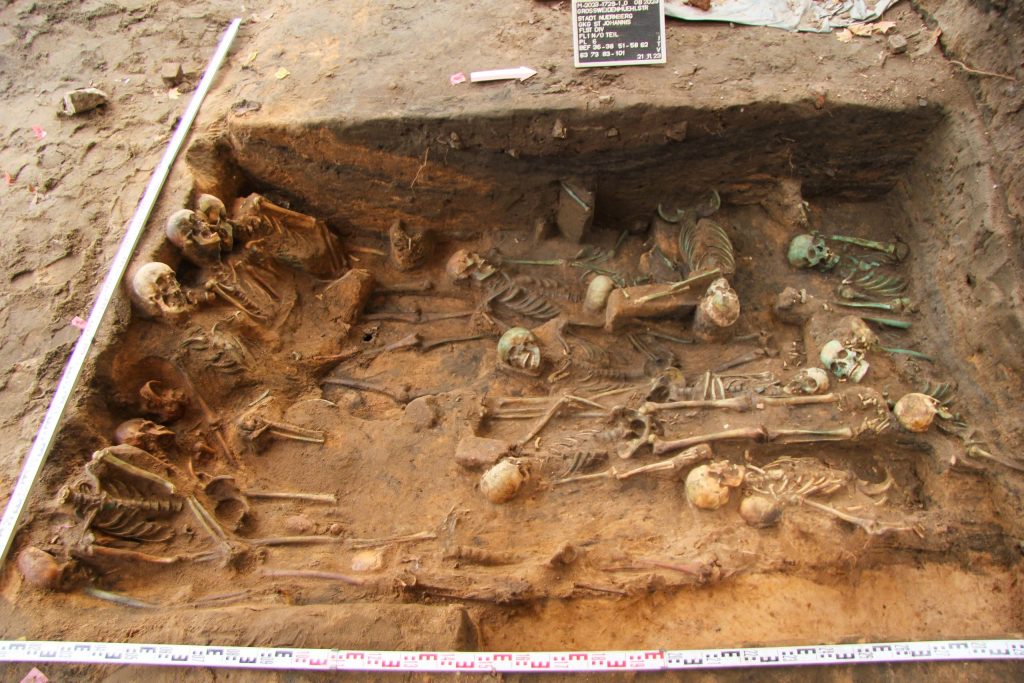In the heart of Nuremberg, a routine construction excavation unearthed a haunting piece of history, delivering a profound reminder of human suffering and resilience. What initially seemed to be World War II casualties quickly revealed a far older and more devastating narrative. Archaeologists uncovered skeletal remains that, through radiocarbon dating, told a chilling story rooted in 17th-century Europe’s darkest days, a time when disease and war converged to leave an indelible mark on humanity.
The skeletal remains were found in a mass grave, an eerie testament to the devastating reach of the plague. Nuremberg, like much of Europe, was no stranger to the merciless grip of this deadly disease. Between 1533 and 1634, the city experienced multiple catastrophic outbreaks of the plague, with the epidemic of 1634 coinciding with the brutal ravages of the Thirty Years’ War. These dual calamities created an environment of unrelenting despair and death. The excavation site, containing hundreds of skeletons, painted a vivid picture of the overwhelming mortality that plagued the region. Some graves contained as many as 280 bodies, evidence of the scale of suffering endured during this tumultuous period.

This discovery provided archaeologists with a rare opportunity to delve into the personal lives of those who lived and perished during this tragic chapter in history. Amid the skeletal remains, poignant artifacts such as coins, pottery, and other personal items were uncovered. These objects served as a bridge between the anonymous bones and the vibrant lives they once represented. Each artifact offered a glimpse into the individuality of the people who had lived centuries ago, transforming the excavation from a grim reminder of mortality into a celebration of lives that were abruptly extinguished by the relentless march of disease.
One of the most remarkable aspects of this find was the preservation of the remains, despite the devastation wrought by World War II bombings. The bombing raids that ravaged Nuremberg during the war had obliterated much of the city’s historical infrastructure. Yet, these skeletal remains and artifacts survived, hidden beneath layers of rubble and time, offering a unique and poignant narrative that spanned centuries. This preservation allowed archaeologists to explore not only the immediate circumstances of the deaths but also the broader historical context in which they occurred.
The convergence of historical tragedies at this site is particularly striking. The devastation caused by the Black Death—a plague that swept across Europe with unparalleled ferocity—was compounded by the horrors of the Thirty Years’ War, a conflict marked by immense suffering and loss. Centuries later, the destruction wrought by World War II added yet another layer to the site’s historical significance. This mass grave serves as a poignant reminder of how human suffering transcends time, with each tragedy leaving its mark on the landscape and the collective memory of humanity.
Archaeological research at this site has provided invaluable insights into the lives and deaths of those who perished. The meticulous examination of the skeletal remains has revealed details about the physical conditions and health challenges faced by people in the 17th century. For example, evidence of malnutrition, chronic illnesses, and injuries consistent with the hardships of war and disease have been identified. These findings not only deepen our understanding of the historical context but also shed light on the resilience and adaptability of the human spirit in the face of unimaginable adversity.
Beyond the physical evidence, this discovery has also offered researchers a chance to explore the genetic makeup of the individuals buried at the site. Advances in DNA analysis have enabled scientists to examine genetic conditions and vulnerabilities that may have contributed to the high mortality rates during the plague. By studying these remains, researchers hope to uncover clues about how the human body responded to the plague and other diseases, potentially paving the way for breakthroughs in modern medicine and public health.
The artifacts discovered alongside the skeletal remains further enrich the narrative of this excavation. Coins, for instance, offer insights into the economic conditions and trade networks of the time, while pottery and other household items provide a glimpse into the daily lives of the people who lived in Nuremberg during the 17th century. These tangible remnants of the past serve as a testament to the enduring human desire to create, trade, and connect, even in the face of overwhelming hardship.
The historical significance of this discovery extends beyond the confines of Nuremberg. It serves as a powerful reminder of the interconnectedness of human history and the ways in which the past continues to shape our present. The mass grave is not merely a site of death; it is a repository of stories, each one reflecting the resilience and fortitude of those who lived through some of history’s most challenging times. By unearthing these narratives, archaeologists provide a voice to the voiceless, ensuring that their experiences are not forgotten.
As researchers continue to analyze the findings from this excavation, the potential for new discoveries remains vast. The study of these remains and artifacts promises to deepen our understanding of the social, economic, and medical aspects of life in 17th-century Europe. Moreover, it underscores the importance of preserving historical sites and artifacts, as they offer invaluable insights into the human experience and serve as a reminder of our shared history.
This mass grave in Nuremberg stands as a stark testament to the resilience of the human spirit. It tells a story of tragedy and suffering, but also one of endurance and hope. The individuals buried at this site lived through some of the darkest days in European history, yet their stories continue to inspire and educate us today. Through the meticulous work of archaeologists and researchers, these long-buried voices remind us of the extraordinary strength of humanity in the face of unimaginable adversity.





